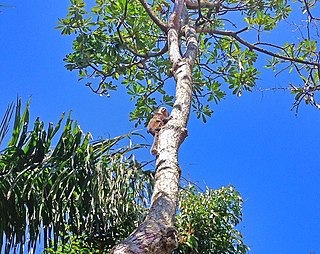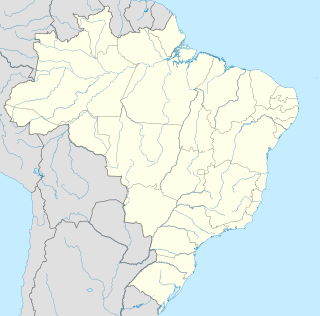
Aspidosperma cylindrocarpon is a timber tree native to Brazil, Paraguay, Bolivia, and Peru. It is common in Atlantic Forest, Cerrado and Pantanal vegetation of Brazil. This plant is cited in Flora Brasiliensis by Carl Friedrich Philipp von Martius. In addition, it is useful for beekeeping.

Aspidosperma macrocarpon is a timber tree native to Brazil, Venezuela, Bolivia, Paraguay, and Peru. It is common in Cerrado vegetation. It has a self-supporting growth form with simple, broad leaves. This plant is cited in Flora Brasiliensis by Carl Friedrich Philipp von Martius, and it is useful for beekeeping. Individual plants can grow up to 25 m.
Aspidosperma ramiflorum is a timber tree native to Brazil and Bolivia.

Aspidosperma subincanum is a timber tree native to Brazil and Bolivia. It is common in Cerrado vegetation in Brazil. It was first described by Carl Friedrich Philipp von Martius in 1838.

Aspidosperma tomentosum is a timber tree native to Brazil, Bolivia, and Paraguay. It is common in of Cerrado vegetation in Brazil. It was first described by Carl Friedrich Philipp von Martius.

Hancornia is a genus of flowering plant in the family Apocynaceae, first described as a genus in 1812. It is native to South America. It contains only one known species, Hancornia speciosa, commonly called mangabeira, which produces fruits known as mangabas.

Himatanthus is a genus of flowering plant in the family Apocynaceae, first described as a genus in 1819. It is native to Panama and South America.
- Himatanthus articulatus(Vahl) Woodson - widespread from Panama east to French Guiana and south to Bolivia
- Himatanthus attenuatus(Benth.) Woodson - Venezuela, Colombia, N Brazil
- Himatanthus bracteatus(A.DC.) Woodson - Venezuela, Colombia, Guianas, Brazil, Peru, Ecuador
- Himatanthus drasticus(Mart.) Plumel - Guianas, Brazil
- Himatanthus lancifolius(Müll.Arg.) Woodson
- Himatanthus obovatus(Müll.Arg.) Woodson - Brazil, Bolivia, Guyana
- Himatanthus phagedaenicus(Mart.) Woodson - S Venezuela, NW Brazil
- Himatanthus semilunatusMarkgr. - Amazon Basin
- Himatanthus stenophyllusPlumel - Colombia, NW Brazil, Guyana, Suriname
- Himatanthus tarapotensis(K.Schum. ex Markgr.) Plumel - Colombia, Bolivia, Brazil, Peru, Ecuador

Itatiaiuçu is a municipality in the state of Minas Gerais in the Southeast region of Brazil.

São Vicente de Minas is a municipality in the state of Minas Gerais in the Southeast region of Brazil.

Marmelópolis is a municipality in the state of Minas Gerais in the Southeast region of Brazil.

Ouro Fino is a city situated in the state of Minas Gerais in the Southeastern Region of Brazil.

São Gonçalo do Sapucaí is a municipality in the state of Minas Gerais in the Southeast region of Brazil.

São João da Mata is a municipality in the state of Minas Gerais in the Southeast region of Brazil.

São Sebastião da Bela Vista is a municipality in the state of Minas Gerais in the Southeast region of Brazil.

São Pedro da União is a municipality in the state of Minas Gerais in the Southeast region of Brazil.
São Bento Abade is a municipality in the state of Minas Gerais in the Southeast region of Brazil.

São Domingos das Dores is a municipality in the state of Minas Gerais in the Southeast region of Brazil.

São Sebastião do Anta is a municipality in the state of Minas Gerais in the Southeast region of Brazil.
São José do Divino, Minas Gerais is a municipality in the state of Minas Gerais in the Southeast region of Brazil.

São Félix de Minas is a municipality in the state of Minas Gerais in the Southeast region of Brazil.











